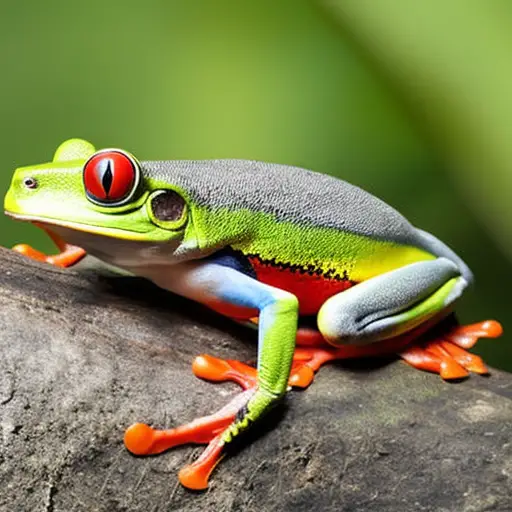How to Identify Poisonous Amphibians and Reptiles

In the lush rainforests of South America, a hiker stumbles upon a brightly colored amphibian. Its vibrant hues and intricate patterns captivate the eye, but a sense of caution sets in. Is this creature harmless or potentially deadly?
Identifying poisonous amphibians and reptiles is crucial for both researchers and outdoor enthusiasts alike. This article will provide a comprehensive guide on recognizing physical characteristics, coloration and patterns, habitat and range, behavior and defense mechanisms, as well as vocalizations and calls of these fascinating yet potentially dangerous creatures.
Physical Characteristics
Poisonous amphibians and reptiles can be identified by their distinct physical characteristics. These creatures have developed various adaptations to survive in their environments, including camouflage techniques and warning signs that serve as a defense mechanism against predators.
One of the most common physical characteristics observed in poisonous amphibians and reptiles is their vibrant coloration. Many species display bright hues of red, yellow, or orange, which act as a warning to potential predators. This phenomenon, known as aposematism, signals their toxicity and deters predators from attacking them.
In addition to their vibrant colors, poisonous species often possess distinct markings or patterns on their bodies. These markings can range from bold stripes to intricate spots, helping them blend into their surroundings or mimic other harmless species. By utilizing camouflage techniques, these creatures are able to avoid detection and increase their chances of survival.
Furthermore, poisonous amphibians and reptiles may also have specialized physical features that aid in their defense. Some species possess spines, bumps, or warts on their skin, which serve as a physical deterrent to predators. These features are often accompanied by a foul odor or a bitter taste, further dissuading predators from attacking.
Coloration and Patterns
Coloration and patterns are important factors to consider when identifying poisonous amphibians and reptiles. These visual cues serve as warning signs to potential predators, signaling the presence of toxins or danger. By understanding the significance of coloration and patterns, one can better distinguish between harmless and potentially harmful species.
-
Warning signs: Many poisonous amphibians and reptiles possess bright and vibrant colors, such as red, yellow, or orange. These bold hues often act as a visual deterrent, warning predators to stay away. Additionally, certain species may have contrasting patterns or markings, such as stripes or spots, which further enhance their warning signals.
-
Mimicry and camouflage: Some poisonous species have evolved to mimic the appearance of other harmless species in their environment. This mimicry allows them to avoid detection and potential predation. Similarly, certain poisonous amphibians and reptiles possess coloration and patterns that blend seamlessly with their surroundings, enabling them to camouflage themselves from both predators and prey.
Understanding coloration and patterns is crucial for correctly identifying poisonous amphibians and reptiles. It provides valuable insight into their defensive strategies and helps us avoid potential risks associated with venomous encounters. By being aware of these visual cues, we can appreciate the remarkable adaptations that these species have developed for survival.
Habitat and Range
The habitat and range of amphibians and reptiles play a crucial role in their identification and understanding their potential toxicity. These organisms are found in a wide variety of habitats, ranging from tropical rainforests to deserts, and from freshwater ecosystems to marine environments. Understanding their habitat and range is essential when identifying and assessing the potential danger they may pose.
Amphibians and reptiles have diverse diet and feeding habits, which are often closely tied to their specific habitats. For example, amphibians such as frogs and salamanders are usually carnivorous, feeding on insects, small invertebrates, and even other amphibians. Reptiles, on the other hand, have a wider range of feeding habits. Some reptiles are herbivorous, consuming plants and fruits, while others are carnivorous, preying on small mammals, birds, and even other reptiles.
Reproduction and life cycle also vary among amphibians and reptiles, and understanding these aspects can aid in identifying and assessing their toxicity. Many amphibians undergo a complex life cycle, starting as aquatic larvae and later transforming into terrestrial adults. Reptiles, on the other hand, typically lay eggs on land and their offspring hatch as independent miniatures of the adult form.
Behavior and Defense Mechanisms
One important aspect to consider when identifying poisonous amphibians and reptiles is their behavior and defense mechanisms. These creatures have evolved various defensive adaptations to protect themselves from predators and potential threats. Understanding their behavior and defense mechanisms is crucial for both researchers and individuals who may encounter these animals in the wild.
Here are some key defensive adaptations and warning signals displayed by poisonous amphibians and reptiles:
-
Camouflage: Many poisonous species have developed the ability to blend into their surroundings, making them difficult to detect by predators. Their coloration and patterns help them blend into their natural habitat, providing them with a survival advantage.
-
Aposematism: Aposematic species have vibrant and contrasting colors that act as a warning signal to potential predators. These colors serve as a visual indicator of their toxicity or venomous nature, warning predators to stay away.
-
Mimicry: Some non-poisonous species have evolved to mimic the appearance of poisonous species. This mimicry deceives predators into thinking that they are toxic as well, providing them with protection against predation.
Vocalizations and Calls
Vocalizations and calls are important auditory cues that can aid in the identification of poisonous amphibians and reptiles. These vocalizations play a crucial role in the communication between individuals of the same species, helping them to establish territories, attract mates, and warn of potential threats. By understanding the different types of vocalizations produced by these animals, we can differentiate between harmless and venomous calls.
Amphibians and reptiles produce a wide range of vocalizations, including chirps, croaks, clicks, grunts, hisses, and whistles. The table below provides examples of vocalizations and their corresponding meanings in amphibians and reptiles:
| Vocalization | Meaning |
|---|---|
| Chirps | Territory establishment |
| Croaks | Mating call |
| Clicks | Distress or alarm |
| Grunts | Aggression or territorial dispute |
| Hisses | Warning |
| Whistles | Courtship display |
It is important to note that while some harmless species may produce calls that mimic those of venomous species, there are certain characteristics that can help differentiate between the two. Venomous calls often have a distinct and harsh quality, with a rapid or repetitive pattern. Additionally, venomous animals may produce calls that are accompanied by other warning signals, such as aggressive postures or bright coloration.
Expert Tips and Resources
To further enhance your knowledge and identification skills, it is essential to seek guidance from experts and utilize reliable resources when identifying poisonous amphibians and reptiles. Here are some expert tips and resources that can help you in your endeavor:
-
Online Courses: Taking online courses can provide you with valuable information about the identification and behavior of poisonous amphibians and reptiles. These courses are designed by experts in the field and cover topics such as identifying features, habitat preferences, and warning signs of toxicity. They often include interactive modules, quizzes, and assessments to test your knowledge.
-
Field Guides: Field guides are an indispensable resource for any herpetology enthusiast. These guides provide detailed descriptions, photographs, and distribution maps of various species. They also include information about their natural history, habitat, and behavior. Look for field guides that specifically focus on poisonous amphibians and reptiles, as they will provide more specific information about the identification and characteristics of these species.
-
Online Databases: Online databases, such as those provided by herpetological societies or research institutions, can be a treasure trove of information. These databases often include comprehensive species profiles, scientific studies, and conservation efforts related to poisonous amphibians and reptiles. They are regularly updated with the latest research and findings, making them an invaluable resource for staying up-to-date with the field.
Frequently Asked Questions
How Long Do Poisonous Amphibians and Reptiles Typically Live?
The average lifespan of poisonous amphibians and reptiles varies depending on various factors. These factors include species, habitat, diet, predation, and environmental conditions. It is important to note that not all amphibians and reptiles are poisonous.
Are All Amphibians and Reptiles With Bright Colors Poisonous?
Not all amphibians and reptiles with bright colors are poisonous. Bright colors can serve as a warning or a form of camouflage. The difference between venomous and poisonous species lies in the method of toxin delivery.
Can a Non-Poisonous Amphibian or Reptile Mimic the Appearance of a Poisonous One to Deter Predators?
Predator deterrent strategies in non-poisonous amphibians and reptiles can include mimicry of the appearance of poisonous species. This strategy aims to deter potential predators by exploiting their learned aversion to brightly colored and toxic animals. The effectiveness of mimicry varies among different species.
Is It Possible to Train a Poisonous Amphibian or Reptile to Be Non-Poisonous?
Training methods for poisonous amphibians and reptiles to become non-poisonous have not been scientifically documented. However, if such methods were to be developed, the potential benefits could include safer handling and reduced risk of harm to humans and other animals.
Are There Any Known Cases of Poisonous Amphibians or Reptiles Losing Their Toxicity Over Time?
There have been documented cases of reduced toxicity in certain species of poisonous amphibians and reptiles. Factors such as changes in diet, habitat, and genetic variations can influence the loss of toxicity over time.
Conclusion
In conclusion, identifying poisonous amphibians and reptiles is crucial for personal safety and conservation efforts. By understanding their physical characteristics, coloration and patterns, habitat and range, behavior and defense mechanisms, as well as vocalizations and calls, individuals can make informed decisions when encountering these species.
Resources and expert advice are valuable in enhancing this knowledge. It is imperative to remain vigilant and cautious, as the knowledge gained can help prevent potential dangers and contribute to the preservation of these unique creatures.





